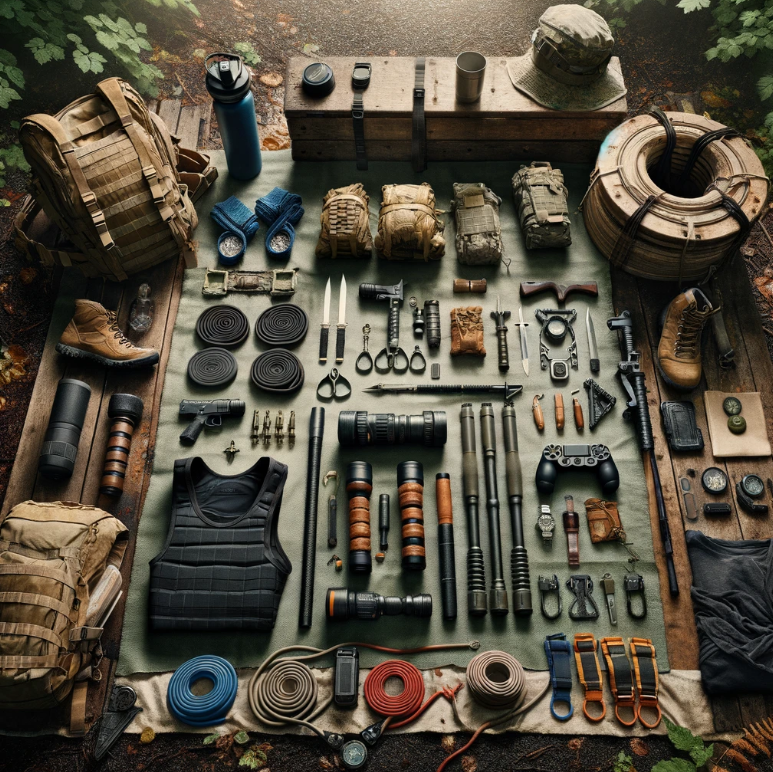Table of Contents
- 1 Introduction to Fitness and Training for Preppers and Survivalists
- 2 The Vital Role of Fitness in Survival Preparedness
- 3 Designing a Survival Fitness Program
- 4 Key Survival Training Workouts
- 5 Practical Applications of Survival Fitness
- 6 Incorporating Mental Toughness and Resilience
- 7 Equipment and Tools for Effective Survival Fitness Training
- 8 Tracking Progress and Staying Motivated
- 9 Final Remarks
- 10 Frequently Asked Questions
- 10.1 What is the importance of fitness and training for preppers and survivalists?
- 10.2 How can one design an effective survival fitness program?
- 10.3 What are some key survival training workouts recommended for preppers?
- 10.4 How does mental toughness play a role in surviving challenging situations?
- 10.5 What tools and equipment are beneficial for effective survival fitness training?
Views: 15
Introduction to Fitness and Training for Preppers and Survivalists
Briefly introduce the importance of physical and mental fitness in survival scenarios

Survival situations demand physical and mental fitness. Being prepared physically and mentally is vital during emergencies. Fitness significantly boosts the chances of surviving challenging circumstances. Survival Workout Routines are workout routines that focus on making sure you’re prepared to face real life challenges.
In survival scenarios, individuals must be ready both physically and mentally. This readiness can mean the difference between life or death in critical situations. Physical strength, endurance, agility, and mental resilience are crucial elements.
Fitness plays a pivotal role in enhancing one’s ability to survive during unexpected events like natural disasters or other emergencies. The capacity to endure physical strain while maintaining mental clarity is essential for overcoming obstacles.
Highlight the aim of the article: to guide preppers in enhancing their survival fitness and training
This article aims to assist preppers in improving their survival fitness levels effectively. Enhancing survival fitness is key for those preparing for unforeseen circumstances such as natural disasters or societal breakdowns.
The focus here is on helping preppers develop efficient training routines tailored towards boosting their overall physical condition. By incorporating specific exercises targeting strength, endurance, flexibility, balance, and coordination, preppers can enhance their readiness levels.
Effective training routines encompass various aspects of physical conditioning that are crucial for surviving demanding situations successfully. Developing a well-rounded approach that includes cardiovascular workouts, strength training exercises, flexibility drills will prepare preppers adequately.
The Vital Role of Fitness in Survival Preparedness
Discuss why physical fitness is crucial for survival situations
Physical fitness plays a vital role in survival scenarios by enhancing strength, endurance, and overall performance. It enables individuals to perform essential tasks efficiently during emergencies. Good physical fitness also boosts resilience and reduces the risk of injuries when facing challenging survival situations.

Maintaining a high level of physical fitness is crucial for survival preparedness as it directly impacts one’s ability to build shelters effectively, source food, and travel long distances on foot during emergencies. For example, individuals who are physically fit can construct sturdy shelters quickly using available resources like branches or leaves. This skill is invaluable in harsh environments where protection from the elements is essential for survival.
Staying fit also aids in activities such as hunting and gathering food when traditional food sources are scarce during emergencies. Individuals with good physical fitness can navigate rough terrains easily to find sources of sustenance like wild edibles or game animals. This capability ensures a more sustainable supply of proteins, vitamins, and minerals necessary for maintaining energy levels during prolonged periods without access to regular meals.
Outline the benefits of staying fit for tasks like building shelters, sourcing food, and traveling long distances on foot

Being physically fit enhances an individual’s capacity to endure strenuous activities involved in constructing shelters under time constraints during emergencies. For instance, someone with good physical condition can lift heavy materials required for building shelter without experiencing fatigue quickly.
Fitness significantly contributes to successful hunting efforts by improving agility and stamina needed to track down prey effectively while conserving energy reserves for other demanding tasks related to securing nourishment.
In cases where transportation options are limited or unavailable due to unforeseen circumstances like natural disasters or societal breakdowns, being physically fit allows individuals to cover extensive distances on foot without succumbing to exhaustion easily.
Staying active through regular exercise routines that focus on strength training helps build muscle mass which supports sustained physical exertion required in diverse emergency situations.
Engaging in cardiovascular exercises improves heart health and lung capacity critical for enduring prolonged periods of intense activity common in emergency scenarios that demand quick decision-making under pressure.
Flexibility exercises enhance joint mobility important for navigating challenging terrains while reducing the risk of strains or sprains that could hinder movement efficiency during critical moments requiring swift responses.
Designing a Survival Fitness Program
Step-by-step guide to creating a fitness regimen tailored to prepping needs
Creating a survival fitness and training program involves tailoring workouts to meet the demands of potential survival scenarios. Start by identifying specific fitness goals based on individual needs and possible situations one might encounter as a survivor.

For instance, if someone lives in an area prone to natural disasters like hurricanes, their focus may be on building endurance for long periods without access to resources.
Designing a comprehensive workout plan is essential for survival fitness. This plan should include various types of exercises such as cardiovascular workouts, strength training routines, and endurance activities. Cardiovascular exercises like running or cycling improve stamina and heart health—critical components for surviving in challenging environments where physical exertion is constant.
Incorporating outdoor activities into the fitness regimen can help simulate real-life survival scenarios. By engaging in hiking or camping trips regularly, individuals can enhance their skills while staying fit simultaneously. These experiences not only improve physical conditioning but also provide opportunities to practice essential survival skills like fire-making or shelter-building.
Include cardiovascular exercises, strength training, and endurance workouts
Cardiovascular exercises play a crucial role in improving overall stamina and heart health—a necessity for any survivor facing physically demanding situations during emergencies. Running or cycling are excellent examples of cardio workouts that boost endurance levels significantly.
Strength training is another vital component of any effective survival fitness program, helping individuals build muscle strength necessary for tasks such as carrying heavy supplies or constructing shelters when resources are scarce. Exercises like weightlifting or bodyweight movements can aid in developing the required muscular power.
Endurance workouts focus on enhancing an individual’s ability to endure prolonged periods of physical exertion—a key attribute needed during survival situations where energy reserves are constantly tested. Activities like long-distance running or swimming can help increase resilience and mental toughness crucial for surviving under duress.
Advice on incorporating outdoor and survival skills training into fitness routines
To make the most out of your fitness routine, consider integrating outdoor activities that mimic potential survival settings into your workout schedule regularly. Hiking through rugged terrain with weighted backpacks can prepare you physically while exposing you to different environmental challenges similar to those faced by survivors.
Practice essential survival skills during outdoor workouts by incorporating tasks such as fire-making using natural materials found around you or building temporary shelters from available resources within your surroundings—skills that could prove invaluable in actual emergency situations requiring quick thinking and resourcefulness.
Enhance your navigational abilities by including map reading exercises or orienteering challenges into your regular fitness routines outdoors. Improving these skills not only boosts confidence when exploring unfamiliar territories but also sharpens decision-making capabilities critical during times of crisis.
Key Survival Training Workouts
Cardiovascular exercises for stamina

Cardiovascular exercises are crucial for building stamina in survival situations. High-intensity interval training (HIIT) is an effective way to boost cardiovascular endurance rapidly. Activities like jogging, cycling, or rowing can also enhance cardiovascular health significantly.
Circuit training, which combines cardio and strength exercises, offers a comprehensive workout that improves overall fitness levels efficiently.
Regularly engaging in cardio workouts, such as running or swimming, can help individuals build the necessary endurance required during challenging survival scenarios. For example, incorporating HIIT sessions into a weekly routine can quickly elevate cardiovascular fitness levels by alternating between intense bursts of activity and short rest periods.
Incorporating aerobic activities like cycling not only enhances heart health but also strengthens leg muscles essential for long-distance movements in survival situations. By blending various forms of cardio exercise into their fitness regimen, individuals can prepare themselves physically for demanding scenarios where sustained physical effort is vital.
Strength training for carrying supplies and building shelters
Strength training plays a critical role in preparing individuals for tasks like carrying heavy supplies or constructing shelters during emergencies. Compound exercises such as squats and deadlifts target multiple muscle groups simultaneously to build overall strength effectively. Functional movements that replicate real-life actions encountered in survival settings are particularly beneficial when preparing for unforeseen challenges.
Utilizing resistance bands or weighted vests during workouts can intensify strength training sessions by adding extra resistance to bodyweight exercises like push-ups or lunges. These additional challenges help individuals develop the strength needed to handle demanding physical tasks commonly faced during survival situations.
By focusing on compound movements that engage various muscle groups simultaneously, individuals can enhance their functional strength while mimicking the types of physical demands they may encounter when navigating through rugged terrains or lifting heavy objects.
Endurance workouts for long treks and survival scenarios
Endurance workouts are essential for building the stamina required to endure long treks or survive challenging circumstances successfully. Gradually increasing both the duration and intensity of endurance activities helps build resilience over time by pushing personal limits progressively.
Training specifically for extended hikes involves incrementally raising mileage targets while acclimating the body to prolonged periods of physical exertion gradually. By simulating real-life conditions through practices like carrying weighted backpacks during endurance sessions, individuals can better prepare themselves mentally and physically for surviving arduous journeys under adverse conditions.
Engaging in regular endurance activities not only boosts physical stamina but also cultivates mental toughness essential when facing unpredictable events requiring perseverance and determination.
Practical Applications of Survival Fitness
Fitness plays a crucial role in survival situations by enhancing agility and balance. When faced with challenging terrains during emergencies, individuals with good fitness levels can navigate these obstacles more effectively. For example, someone who is physically fit will find it easier to climb steep inclines or maneuver through dense forests when trying to reach safety.

In survival scenarios, having optimal fitness enables individuals to overcome various physical obstacles that may arise. Whether it’s lifting heavy objects, carrying supplies over long distances, or even assisting injured companions, being in good shape ensures that one can handle these tasks efficiently. This capability is especially vital when resources are limited and every action counts towards increasing the chances of survival.
Adapting and responding swiftly to unexpected situations is a key aspect of surviving challenging environments. Good fitness levels contribute to this adaptability by boosting endurance and stamina. These attributes allow individuals to react promptly when faced with sudden changes or dangers in their surroundings. For instance, someone who is physically fit will be better equipped to run for extended periods if needed or perform demanding tasks without getting fatigued quickly.
Tips for integrating survival skills into fitness training
Integrating survival skills into regular fitness routines adds a practical dimension to workouts while enhancing preparedness for unforeseen circumstances. One way to achieve this integration is by combining traditional exercises with activities that mimic real-life survival tasks. For example, incorporating chopping wood as part of strength training sessions not only builds muscle but also hones the skill of gathering firewood for warmth in outdoor settings.
Another effective method is practicing shelter-building techniques during workout sessions focused on endurance and flexibility. By constructing temporary shelters using natural materials like branches and leaves after completing intense cardio exercises, individuals develop both physical resilience and practical knowledge essential for creating safe havens in emergency situations.
Circuit training routines offer an excellent opportunity to merge fitness goals with survival skill practice effectively. Including activities such as fire-making drills between sets of different exercises keeps participants engaged while simulating scenarios where quick decision-making under pressure is required.
Benefits of merging survival skills training with fitness regimens
The fusion of survival skills training with regular fitness programs offers numerous advantages beyond physical health improvements alone:
- Enhances overall readiness: Integrating survival techniques prepares individuals mentally and physically for unexpected challenges.
- Boosts problem-solving abilities: Practicing fire-making or shelter-building within workouts sharpens critical thinking skills necessary for devising solutions on the spot.
- Increases self-reliance: Acquiring proficiency in basic survival skills fosters independence by reducing reliance on external assistance during emergencies.
- Improves resourcefulness: Combining practical tasks like water purification methods with exercise routines encourages creativity in utilizing available resources efficiently.
- Builds confidence: Mastering essential wilderness skills alongside achieving personal fitness goals instills a sense of accomplishment and self-assurance.
Incorporating Mental Toughness and Resilience
Discuss the importance of mental fitness in surviving challenging situations

Survival fitness isn’t just about physical strength; it also involves mental toughness. In high-stress scenarios, individuals with good mental fitness can remain calm and focused, making critical decisions effectively. Being mentally prepared is key to staying composed during emergencies.
Building mental resilience is crucial for enhancing problem-solving skills and decision-making abilities when faced with unexpected challenges. Those who have honed their mental ability to think clearly under pressure are better equipped to navigate survival situations successfully. Good mental fitness enables individuals to adapt quickly and cope effectively in adverse circumstances.
Good mental fitness improves adaptability and coping mechanisms during survival scenarios by allowing individuals to stay rational amidst chaos. With a strong mindset, people can tackle obstacles creatively, finding solutions even in the most dire circumstances. The core of survival lies not just in physical prowess but also in a refined ability to handle stress mentally.
Strategies for building mental resilience
To cultivate mental resilience, individuals must engage in stress management techniques that help maintain composure during challenging situations. Practicing mindfulness and relaxation exercises can significantly reduce stress levels when facing adversity or uncertainty. By incorporating these strategies into daily routines, one can develop inner strength essential for survival scenarios.
Scenario-based training is an effective method for simulating real-life emergencies and testing problem-solving skills under pressure. Engaging in such training allows individuals to practice making quick decisions while dealing with unexpected challenges accurately. Through repeated exposure to stressful scenarios, one’s ability to think critically becomes more refined over time.
Seeking professional guidance or joining support groups focusing on mental well-being is crucial for emergency preparedness efforts aimed at improving overall self-reliance during crises. These resources provide valuable insights into managing stress effectively and building psychological endurance necessary for surviving extreme conditions.
Equipment and Tools for Effective Survival Fitness Training
Having the right equipment can make a significant difference in your workout routine. Weighted vests, resistance bands, and portable fitness gear are essential tools that can enhance your training sessions.

Weighted vests are beneficial as they add extra weight to your body during exercises, increasing the intensity of your workouts. This added resistance helps build strength and endurance effectively. For instance, wearing a weighted vest while doing push-ups or squats challenges your muscles more than regular bodyweight exercises.
Resistance bands are versatile tools that offer various options for strength training without the need for bulky gym equipment. They come in different levels of resistance, allowing you to adjust the difficulty of your workouts easily. With resistance bands, you can perform exercises like bicep curls, shoulder presses, or leg extensions anywhere at any time.
Portable fitness gear such as collapsible weights or suspension trainers provide convenience by enabling you to work out in different environments. These tools are lightweight and easy to transport, making them ideal for outdoor workouts or when traveling. For example, using suspension trainers like TRX allows you to engage multiple muscle groups with bodyweight exercises wherever you go. A side note is having a first aid and emergency preparedness kits can be useful in the event of workout injuries in the field.
Benefits of Using Essential Fitness Equipment for Survival Training
- Weighted vests increase workout intensity
- Resistance bands offer versatility without heavy equipment
- Portable gear enables convenient workouts on-the-go
Effective survival fitness training involves utilizing various types of equipment tailored to improve overall physical preparedness in challenging situations.
Incorporating Gear into Your Routine
- Start by incorporating weighted vests gradually into your workouts.
- Experiment with different resistances offered by resistance bands.
- Utilize portable fitness gear during outdoor activities or travel.
Tips for Maximizing Equipment Usage
- Ensure proper form when using weighted vests to prevent injuries.
- Regularly clean and inspect resistance bands for wear and tear.
- Familiarize yourself with setup procedures before using portable fitness gear.
Tracking Progress and Staying Motivated

Setting realistic goals is essential in survival fitness and training to ensure continuous improvement. Align short-term objectives with long-term goals for steady progress. Regularly assess physical capabilities to monitor improvements in fitness levels accurately.
Varying workouts can help maintain interest and prevent boredom, making it easier to stay motivated. Seeking accountability partners can provide support and encouragement throughout the journey. Celebrating milestones along the way, such as achieving a new personal best or completing a challenging workout, can boost motivation.
Joining local fitness or outdoor groups can create a sense of community among individuals interested in survival fitness. Participating in group activities fosters camaraderie and motivation while engaging with like-minded peers who share similar interests. Online communities or forums dedicated to survival fitness offer valuable advice, support, and encouragement from individuals facing similar challenges.
Incorporating achievable short-term goals that align with long-term objectives ensures consistent progress in survival fitness training. Regular assessments of physical capabilities help track improvements effectively by providing tangible evidence of growth over time through increased strength, endurance, or flexibility.
Final Remarks

In the realm of survival fitness and training, the foundation laid in understanding the critical role of physical and mental preparedness cannot be overstated.
Crafting a well-rounded survival fitness program, incorporating key workouts, mental resilience, and utilizing the right equipment are all pivotal steps towards enhancing one’s readiness for unforeseen challenges.
Tracking progress and maintaining motivation serve as essential pillars in this journey towards optimal survival fitness.
Embracing a holistic approach to survival fitness not only equips individuals with the physical capabilities needed in exigent situations but also cultivates a resilient mindset crucial for navigating adversity.
As you delve deeper into the realm of survival fitness and training, remember that consistent practice, adaptability, and a commitment to growth are key elements in honing your skills.
Stay dedicated to your training regimen, continue exploring new techniques, and always strive to push your boundaries further for ultimate preparedness.
Frequently Asked Questions
What is the importance of fitness and training for preppers and survivalists?
Fitness and training are crucial for preppers and survivalists as they enhance physical strength, endurance, and mental resilience necessary during emergencies or disasters. They prepare individuals to handle challenging situations effectively.
How can one design an effective survival fitness program?
Designing a successful survival fitness program involves assessing individual strengths and weaknesses, setting specific goals, incorporating diverse workouts focusing on strength, endurance, flexibility, and agility. It should be tailored to meet the demands of potential survival scenarios.
What are some key survival training workouts recommended for preppers?
Key survival training workouts include functional exercises like bodyweight movements (push-ups, squats), cardiovascular activities (running, swimming), agility drills (obstacle courses), outdoor skills practice (hiking with a loaded backpack), self-defense techniques to ensure all-around preparedness.
How does mental toughness play a role in surviving challenging situations?
Mental toughness is essential for surviving challenges as it helps individuals stay focused under pressure, make quick decisions calmly when faced with adversity. Developing mental resilience through training prepares one to cope with stressors effectively during emergencies or crisis situations.
What tools and equipment are beneficial for effective survival fitness training?
Tools such as weighted vests, resistance bands, kettlebells; equipment like compasses/gps devices for navigation; hiking boots/shoes suitable for rough terrains; water bottles/hydration packs are beneficial for enhancing various aspects of physical conditioning required in survival fitness training routines.



